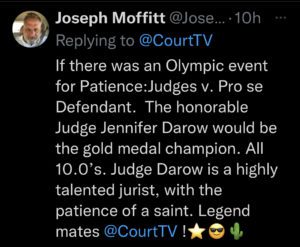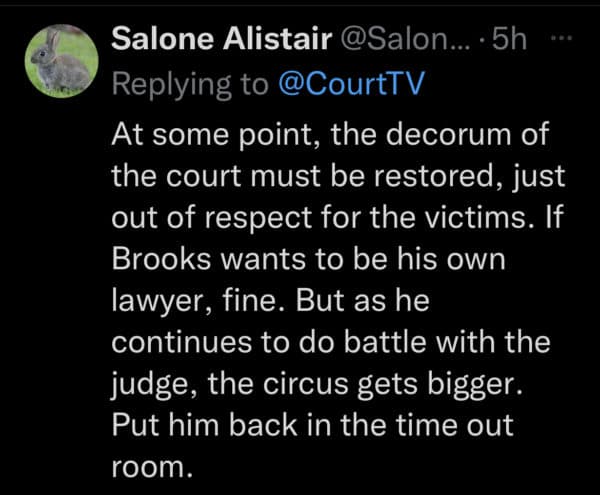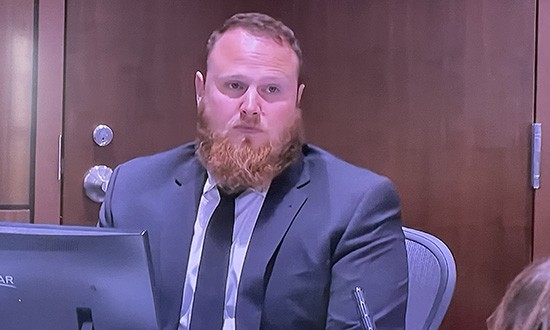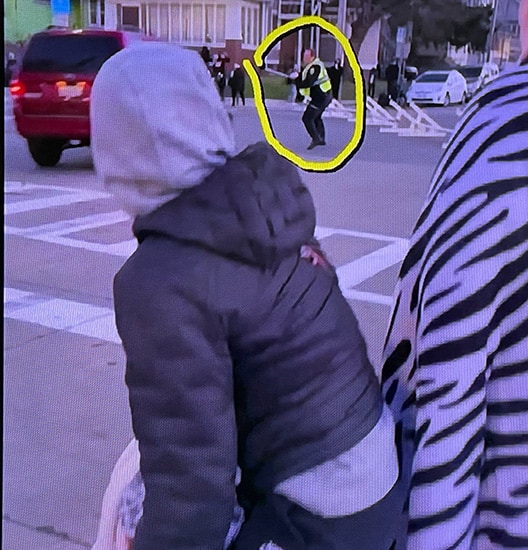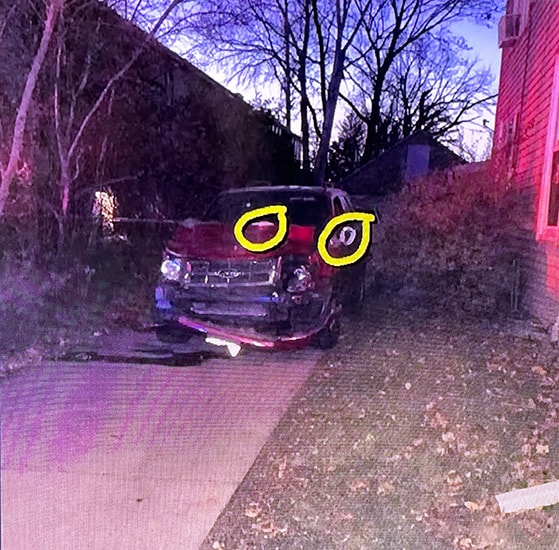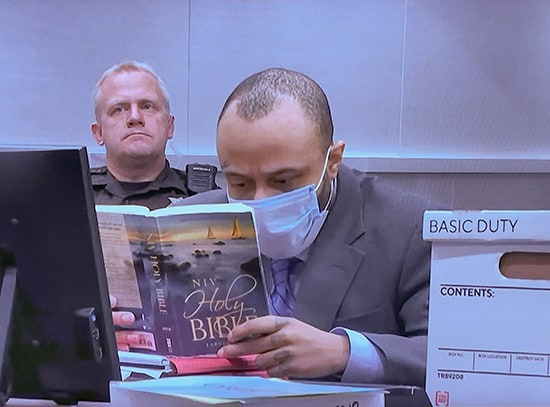Waukesha Christmas-Parade Trial, Day Seven
- Post AuthorBy Anastasia Katz
- Post DateSat Oct 15 2022
The Waukesha Christmas parade murder trial went into its seventh day. Darrell Brooks, Jr., who drove an SUV through a crowd of people, started the day by babbling about a lawsuit and insisting that he doesn’t identify as Darrell Brooks. All week, he has wasted the court’s time making nonsensical arguments and misusing legal terminology. Judge Jennifer Dorow told him to let the trial proceed, but he refused, so she sent the jury out. She warned Mr. Brooks she would send him out to the adjoining courtroom if he was disruptive when the jury came back. Mr. Brooks was put into this kind of “time out” on the first two days of trial, but he has since remained in the courtroom. Twitter users watching the trial on TV were divided over whether the judge was too lenient or should be praised for her patience.
When the jury came back, Mr. Brooks managed to control himself and the first witness was sworn in.
Craig Liermann, a police officer, wore his uniform in court, but he was not on duty on the day of the parade. He went with his family as a spectator. The Catholic Communities group had just passed, and there was a space between groups. The Dancing Grannies were coming up on his right. Officer Liermann heard the crowd become more excited than normal, so he knew something was happening. He saw a red Ford Escape going much too fast. The engine was revving more than normal, so he wondered if there was a mechanical failure or if something was wrong with the driver.
He got a good look at the driver, a light-skinned black male, mid-30s, with long dreadlocks: “As he was driving by, the window was open. He stuck his head and the upper portion of his body out the window and looked behind him.” The driver leaned so far out the window that the officer thought he might fall out. When the driver turned to face front, the officer’s “heart sank,” because it was clear he was intentionally plowing through the parade. He “pulled himself up off the seat and cranked the steering wheel to the right.”
Officer Liermann said that if the driver had kept going straight, he would have gone through a gap between the marchers and the spectators, and would not have hit anyone. The officer described the driver: “There was no panic. There was no distress, like he was trying to stop the vehicle. In fact, he seemed to me like he was excited about what he was doing. . . happy about what was going on.”
He hit many people. Some bounced off the hood; some were run over. The SUV did not slow. There were no brake lights on.
Mr. Brooks interrupted the officer’s testimony to say that his window had been up, but the state showed the jury a photo with the window open as he drove.
There was a score of victims and Officer Liermann went to give first-aid. He helped some into a sheriff’s car to take them to the hospital.
Another off-duty police officer who attended the parade was Ralph Salyers III, whose daughter marched in the parade. When she was finished, they decided to go home. As they walked to their car, Officer Salyers noticed a Ford Escape driving behind some houses, through yards, and then he heard a crash. The car turned down a driveway, and Officer Salyers could see the front was badly damaged. The driver got out, looked at the damage, then yelled, “Fuck!” He appeared panicked. He took things out of the car and ran.
Officer Salyers called 911. He had to call four times to get through, since so many emergency calls were coming in from the parade. He gave the operator the car’s plate number, and police arrived quickly.
When the state asked Officer Salyers what the driver looked like, he said, “You mean what was he wearing?” The DA had to ask specifically what the race of the suspect was, and then the officer answered that he was a light-skinned African American or possibly a Hispanic male. Mr. Brooks was asked to remove his mask, and Officer Salyers identified him, saying he was 100 percent sure it was the same man. He added that Mr. Brooks’ hair is very short now, but it was longer then.
The next witness was Officer Bryce Scholten, who fired at Darrell Brooks in an effort to stop him. Officer Scholten was controlling traffic at the parade, with a neon yellow vest over his uniform. He heard on his radio that officers were dispatched to a domestic fight in Frame Park, and he blocked traffic to make it easier for their cars to get through. Then he heard someone call for an ambulance on the parade route because someone had been hit.
Officer Bryce Scholten
More and more people began calling for ambulances. He could tell the problem was moving westbound along the parade route, and he was at the western end of it. He walked past his barricade into the street, but there was a bend in the road, so he couldn’t see very far. Then he heard screams, not just on his radio, but from people nearby. Then he saw a red blur coming around the bend.
Officer Scholten realized it was an SUV. The hood was smashed up to the windshield, and the front bumpers and fenders were badly damaged, as if it had collided with another vehicle. After hearing so many calls about people being hit, Officer Scholten realized that this speeding SUV must have hit them. He told the jury, “I knew that this vehicle . . . had rammed through the entire parade route and likely severely injured people or killed people, and at that point, I thought it was a terror attack.”
The vehicle accelerated toward Officer Scholten, and he decided to shoot. The easiest shot would be through the windshield, but there were many people, including children, behind the car, and he didn’t want to hit anyone. As the car passed, he was close enough to touch it. He got a good look at the driver and fired three shots. The SUV ran over barricades and left the parade route. Mr. Brooks took off his mask so Officer Scholten could identify him.
Officer Scholten about to fire at Darrell Brooks.
On cross-examination, Mr. Brooks asked if the suspect in the Frame Park incident had a knife. (Mr. Brooks had been fighting with his girlfriend and her roommate, and someone had falsely reported that he had a knife.)
Officer Scholten replied sternly, “I do not know if the suspect from that incident, which was you –”
“What do you mean?”
“Darrell Brooks. You were the suspect in that incident . . . . I do not know if you were armed when you were taken into custody.”
Mr. Brooks said, as he has repeatedly, “I do not identify by that name.” He then went over a map of the parade route, and asked the officer to point out the barricades along Main Street. He tried to make the point that he couldn’t leave the parade route because the streets were blocked by barricades. He asked if it was true that if someone wanted to leave the parade route, the barricade would stop him. Officer Scholten replied that they had just watched a video of Mr. Brooks driving his SUV through a barricade.
“There’s plenty of ways to exit the parade route,” Officer Scholten added. “You can stop, after being given lawful orders by officers, and they could have directed you off the parade route in a safe manner. You could have stopped the vehicle at any point. Or, you could have driven through plastic barricades, like you did where I was located.”
Mr. Brooks again questioned the officer’s use of “you.”
“You, Darrell Brooks,” he said.
Mr. Brooks asked how he “was able to obtain information about the name.”
“I didn’t know your name when I shot at you,” Officer Scholten replied. “You were arrested within 30 or 40 minutes, and you were identified as Darrell Brooks.”
“Were you aiming for the driver?”
The officer said he was aiming for “You, Darrell Brooks. . . I was aiming at you, yes.”
Mr. Brooks asked, “Would any of those shots be kill shots?”
“Yes.”
“Would firing a kill shot at anyone be terrifying?”
The officer agreed that it would be.
“Is it possible the driver could have been killed?”
“Yes.”
Mr. Brooks asked if he could have shot out a tire. The officer said that would not stop the car, and Mr. Brooks agreed that a vehicle with a blown tire could keep moving.
Officer Scholten said, “I’m trained to stop the threat. You were the threat. The vehicle was the weapon . . . so that is why I shot at you.”
Officer Scholten later learned that he had missed Mr. Brooks. His bullets hit the red SUV, and none had gone any further.
Officer Christopher Moss marched as part of the Waukesha PD’s color guard, which leads the parade carrying the American and Wisconsin flags. He finished the parade and went back to the police station to work his shift. He heard the call about a man with a knife in Frame Park, and then he heard officers screaming on the radio, asking for more officers to go to the parade route. He rushed over and saw people lying on the ground everywhere, with others yelling and screaming. He helped two elderly women. Then he came across Officer Scholten, who said he had just fired shots at a badly damaged red Ford Escape, and that they needed to find it.
Officer Moss drove off to look. A Hispanic man flagged him down and said he knew where the vehicle was. The man got into his squad car and directed him to the SUV. A vehicle parked at 338 Maple Street matched the description Officer Scholten had given. The front of the SUV was heavily damaged, with clothing stuck on the hood, a white headband hanging from a rearview mirror, and a bullet hole in the passenger-side windshield.
He found papers inside the car that identified Darrell Brooks Jr., black male, DOB, Feb. 21, 1982. Officer Moss ran the license plate and found that the car belonged to Dawn L. Woods in the city of Milwaukee. He did not know the relationship between the owner and the suspect. (It is mother and son.) He heard on the police radio that another officer had arrested a man named Darrell Brooks.
When Mr. Brooks cross-examined, he asked if Officer Moss had seen news reports about the incident, a question he has asked most of the witnesses so far. Judge Dorow sent the jury out.
Perhaps Officer Scholten’s no-nonsense testimony inspired her to get a little tougher or perhaps, after letting the defendant rant for nearly an hour the day before, her patience had run out. She asked Mr. Brooks to provide a legal basis for his question. Mr. Brooks said it was “obvious,” but the judge told him to explain. The defendant said, “It goes towards biasness.”
She asked how, and Mr. Brooks replied, “How would it not?”
The judge said, “That’s not a proper legal argument.” He had to make an offer of proof.
This was the first time she made the defendant explain a line of questioning, and he was flummoxed. “You allowed it anyway, so what does it matter at this point?”
She asked again for an offer of proof, and he said he did not need to make one because it’s clear. When that answer wasn’t good enough, Mr. Brooks argued, “The prosecution can ax (sic) anything they wanna ax (sic)!” He claimed all of his objections were “cast aside.”
The judge tried to explain the process to him by saying she’s like an umpire, making calls based on a rulebook. “Your ignorance of the law is not a defense for any of this. . . . I’m calling these legal shots as I see them.”
He said that if she was the referee, she wasn’t “reffing fair.”
The last witness of the day was a Hispanic man who lives in the house where Darrell Brooks abandoned the car. The man saw through a second-story window that a “really beat up” red SUV was parked in a driveway. He saw the driver get out of the car and run.
Judge Dorow dismissed the jury for the weekend. Mr. Brooks held an open Bible in front of himself as she did so.
The trial resumes Monday morning.
Editor’s note: We will no longer post daily coverage of this trial. Most of the remaining testimony will be about death and injury, and is not likely to add much to the bigger picture. We will publish a detailed account of closing statements and of Darrell Brooks’s testimony if he takes the stand.
- Post TagsBlack on White Crime, Crime, Murder
